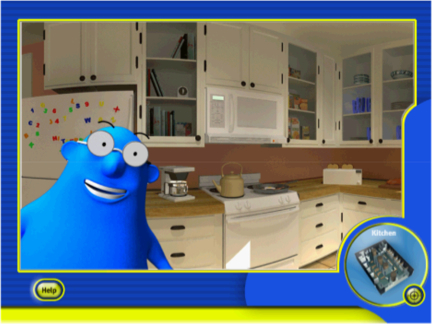Goals
We explored the question using visual scenes and intelligent agents (IA) as communication supports for persons with autism in two ways:
- We conducted a national survey to investigate the features and patterns of Electronic Screen Media preferred by persons with autism spectrum disorder (ASD).
- We created a virtual environment and introduced it to persons on the autism spectrum.
Progress to Date
Survey research conducted by the AAC-RERC explored the level of interest by persons with ASD to interact with electronic screen media including the television, DVD and computer screen. Furthermore, this work has demonstrated that many children with autism spectrum disorder (ASD) spend more time with electronic screen media than all other forms of entertainment combined. Not surprisingly they showed considerable operational competence, with such media that enabled them to control it (e.g., turn on, off, replay, etc). This research also demonstrated that persons on the autism spectrum showed a preference for animated characters over typical human characters. Many persons on the spectrum immediately imitated what they observed or heard through this media while others engaged in delayed or deferred imitative behaviors. Given the findings that persons with ASD have a predilection for this media and in particular animated characters, it raises the question as to how optimize the use of this media for instructional purposes.

In related work, we developed Puddingstone Place©, an interactive virtual environment software application. Its design and evolved from our research and clinical practice which suggested the need for a software application rich in sound, graphics and animation that focused on communication, cueing, sound awareness and language-learning of children with ASD. The instructional goal of the interactive software was to assist children with ASD with their communication and language learning difficulties. Specifically, Puddingstone Place© is a two-story house, comprised of seven photo-realistic rooms, each incorporating common household objects (see Figure 1) that can produce associated sounds, movements, and labels (names) when a learner navigates around the rooms and activates them. In navigating this virtual environment, children with ASD have enhanced their ability to communicate as demonstrated by their increased ability to label, responses to questions about objects within the environment and increases in learned sight vocabulary words (Shane, 2007). To date, hundreds of children with ASD are using Puddingstone Place©.
Next Steps
1.To expand the virtual house into a virtual community
2.To explore more effective ways to use visual scenes contained within a virtual environment as an AAC application
3.To study mentoring characters (intelligent agents) as vehicles for learning by persons on the autism spectrum
Publications
Shane HC, Ducoff P. Electronic screen media for persons with autism spectrum disorders: results of a survey. Journal of Autism and Development Disorders (In press).
Shane HC. (2006). Using visual scene displays to improve communication and communication instruction in persons with autism spectrum disorders. Special Interest Division 12, Perspectives on Augmentative and Alternative Communication. 15, 7-13.
For more information about this project, contact Howard Shane.